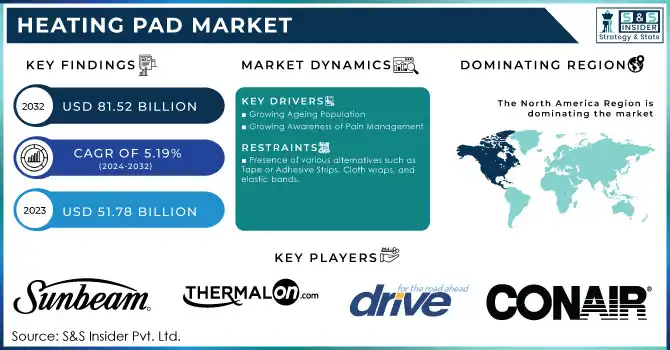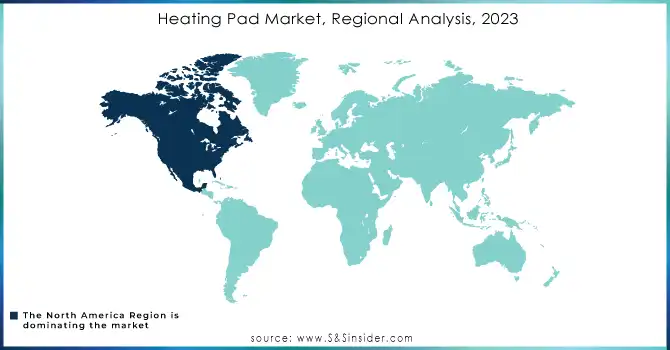Heating Pad Market Size & Overview:

To Get More Information on Heating Pad Market - Request Sample Report
The Heating Pad Market size was valued at USD 51.78 billion in 2023 and is expected to grow to USD 81.52 billion by 2032 and grow at a CAGR of 5.19% over the forecast period of 2024-2032.
The production, distribution, and sale of heating pads are referred to as the "Heating Pad Market." Devices called heating pads are made to deliver localized heat therapy for a variety of uses, including pain reduction, muscle relaxation, and easing discomfort.
Heating pads are devices made to deliver localized heat therapy for a variety of uses, including pain reduction, muscle relaxation, and comfort. Heating components, which may be electric or chemical-based, are often found inside a soft, flexible pad or wrap that is used as a heating pad.
There are electric and non-electric varieties of heating pads available on the market. Electric heating pads primarily use electricity to produce and control heat and frequently have temperature controls and safety automatic shut-offs. On the other hand, non-electric heating pads often use microwave heating or chemical reactions to provide warmth.
Heating Pad Market Dynamis
KEY DRIVERS:
-
Growing Ageing Population
-
Growing Awareness of Pain Management
Growing Awareness of Pain Management: As people become more aware of the advantages of pain management and the use of non-pharmacological treatments, the demand for heating pads has increased. Heating pads are well known for their effectiveness in reducing aches and pains, stiffness, and other discomforts.
RESTRAINTS:
-
Presence of various alternatives such as Tape or Adhesive Strips, Cloth wraps, and elastic bands.
Elastic Bands: You can use elastic bands to secure the heating pad if it has an elastic pocket or loops. The bands should be wrapped around the pad and fastened to neighbouring furniture or items.
OPPORTUNITY:
-
Technological developments
-
Rising adoption and awareness
Rising adoption and awareness: People are becoming more and more aware of the advantages of using heading pads for pain alleviation, relaxation, and stress management. Businesses now have the chance to inform consumers of the benefits of heading pads and encourage greater use. Heading pads have changed along with technological developments, including the incorporation of smart features like wireless connectivity, customizable temperature settings, and automatic shut-off timers. Businesses can benefit from these developments by creating inventive heading pads that provide consumers with greater usefulness and convenience. A variety of target markets the uses for heading pads are numerous.
CHALLENGES:
-
Market Saturation
-
Price Pressure
Price Pressure: The heading pad market faces a lot of price competition. There are several options available to consumers, including affordable substitutes and generic brands. Manufacturers are under pressure to provide competitive pricing while retaining quality as a result. Rapid technology improvements have raised consumer expectations for more cutting-edge features and functionalities in heading pads.
IMPACT OF RUSSIAN-UKRAINE WAR:
The Heating Pad Market, among others, has been significantly impacted by the Russian-Ukrainian conflict. Disruptions to supply chains: If there are trade restrictions, transportation problems, or infrastructure damage, the conflict may result in supply chain disruptions. These elements may affect the supply of finished heating pad goods, components, and raw materials, thereby causing shortages or delays. Costs of manufacturing could rise if the conflict has an impact on Ukraine's industrial capacity.
IMPACT OF ONGOING RECESSION:
Consumer spending typically decreases during a recession as people become more frugal with their money. The heading pad market, among other businesses, may be impacted by this. Here are a few possible outcomes.
Customers may spend less on non-essential items like heading pads because they will be prioritizing the essentials. People may put off or forego acquiring new heading pads due to their diminished purchasing capacity, which will lessen market demand.
IMPACT OF COVID-19:
Due to the epidemic, demand, production, and consumer behaviour have changed for heating pads, which are frequently used in sports like football. Some of the major effects are as follows:
A lot of heating pads are produced in nations that have been severely impacted by the pandemic, such as China. Production delays and problems with the supply chain have been caused by lockdowns, limitations, and transportation disruptions. Heading pads are now less readily available in some areas as a result of this.
Sports participation decreased as a result of the COVID-19 epidemic, which forced several sporting events and activities to be postponed or cancelled. Soccer leagues, competitions, and practice sessions were organized.
Heating Pad Market Segmentation Outlook
By Product Type
-
Microwavable Heating Pads
-
Electric Heating Pads
-
Chemical Heating Pads
By Application
-
Home Use
-
Medical Use
-
Commercial Use
-
Other Use
By End Use
-
Homecare
-
Diagnostic Centers
-
Hospitals
-
Clinics
-
Others
REGIONAL COVERAGE:
North America
-
Germany
-
France
-
the United Kingdom
-
Mexico
-
the Netherlands
-
Switzerland
-
Belgium
-
Russia
-
Italy
-
Spain
-
Turkey
Europe
-
China,
-
Japan,
-
India,
-
South Korea,
-
Singapore
Asia-Pacific
-
Japan
-
South Korea
-
China
-
India
-
Australia
-
Rest of Asia-Pacific
The Middle East & Africa
-
Israel
-
UAE
-
South Africa
-
Rest of the Middle East & Africa
Latin America
-
Brazil
-
Argentina
-
Rest of Latin American
Heating Pad Market Regional Analysis
North America dominates the heating pad market Due to the widespread use of heating pads among the working and obese population, the market in North America is predicted to maintain its customary sizeable market share during the upcoming term.
Asia Pacific market with a high CAGR the demand for heating pads in densely populated growing nations like India, China, Japan, South Korea, and other South Asian Countries is likely to generate significant growth in the Asia Pacific market. Heat therapy for body ailments is more popular in South Asian countries. China supplies most of the heating pads.

Do You Need any Customization Research on Heating Pad Market - Enquire Now
Key Players
The Major Players are Nature Creation, Dongguan Yu Xin Electronic, Thermalon, Sunbeam, Drive Medical, Conair, Beady Heat Therapy, Walgreens, Sunny Bay, Dongguan Yongqi, Bodymed, Milliard, Chattanooga Medical Supply, Pure relief, Carex, Thrive, Beurer, Kaz & Other player are listed in the final report.
| Report Attributes | Details |
| Market Size in 2023 | USD 51.78 Billion |
| Market Size by 2032 | USD 81.52 Billion |
| CAGR | CAGR of 5.19% From 2024 to 2032 |
| Base Year | 2023 |
| Forecast Period | 2024-2032 |
| Historical Data | 2020-2022 |
| Report Scope & Coverage | Market Size, Segments Analysis, Competitive Landscape, Regional Analysis, DROC & SWOT Analysis, Forecast Outlook |
| Key Segments | • By Product Type (Microwavable Heating Pads, Electric Heating Pads, Chemical Heating Pads) • By Application (Home Use, Medical Use, Commercial Use, Other Use) • By End Use (Homecare, Diagnostic Centres, Hospitals, Clinics, Others) |
| Regional Analysis/Coverage | North America (USA, Canada, Mexico), Europe (Germany, UK, France, Italy, Spain, Netherlands, Rest of Europe), Asia-Pacific (Japan, South Korea, China, India, Australia, Rest of Asia-Pacific), The Middle East & Africa (Israel, UAE, South Africa, Rest of Middle East & Africa), Latin America (Brazil, Argentina, Rest of Latin America) |
| Company Profiles | Nature Creation, Dongguan Yu Xin Electronic, Thermalon, Sunbeam, Drive Medical, Conair, Beady Heat Therapy, Walgreens, Sunny Bay, Dongguan Yongqi, Bodymed, Milliard, Chattanooga Medical Supply, Pure relief, Carex, Thrive, Beurer, Kaz |
| Key Drivers | • Growing Ageing Population • Growing Awareness of Pain Management |
| Market Opportunities | • Technological developments • Rising adoption and awareness |

